Crypt of the NecroDancer is a procedurally-generated dungeon crawler about a woman named Cadence whose heart is stolen by a necromancer. To reclaim her heart she raids the villain’s crypt, moving and fighting monsters to the pulsing rhythm of electronic music, until she reaches the bottom and challenges the NecroDancer himself. It’s a fantastic idea, brilliantly executed, built around a catchy chiptune soundtrack—and it’s punishingly difficult. Even after I’ve learned the patterns for fighting all the NecroDancer’s minions, my success or failure largely depends on my ability to keep an effect multiplier up by not missing a beat. This isn’t easy when I’m asked to make multiple split-second decisions without a break. Crypt of the NecroDancer is a videogame I want to like more than I am able to, and I find myself wishing that it was more forgiving, with a better equipment system, and maybe it would be cool if all the music was taken from the Legend of Zelda series.
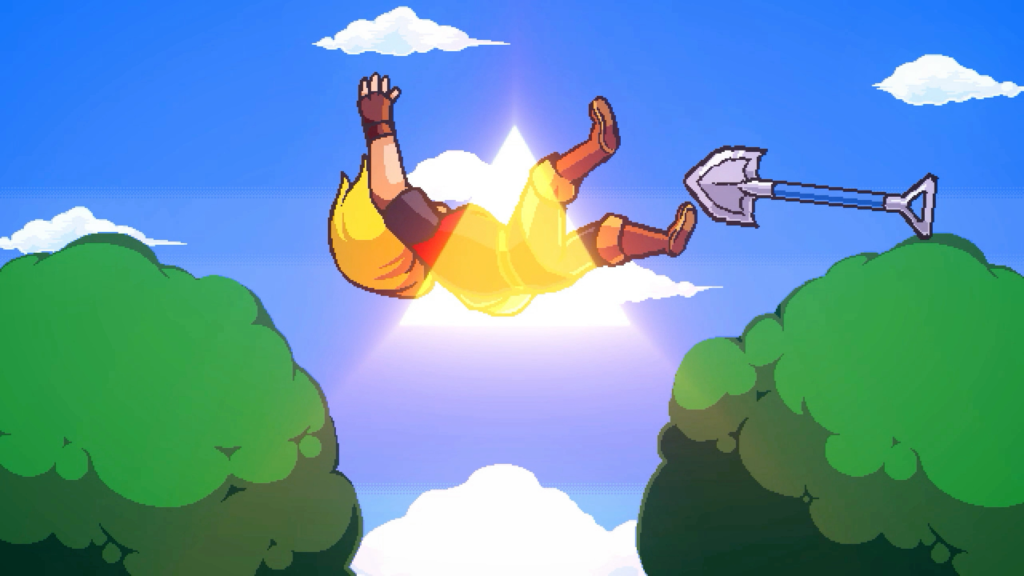
Cadence of Hyrule: Crypt of the NecroDancer featuring The Legend of Zelda is the ponderously-titled sequel to Crypt of NecroDancer. After defeating the NecroDancer and reclaiming her heart, Cadence is pulled through a portal and appears with a flash of golden light in Hyrule, the traditional setting of The Legend of Zelda series. As is often the case, Hyrule is menaced by a villain who wants to use the Triforce, the wish-granting icon of Hyrule’s creation goddesses, to claim power. In this Legend the villain is Octavo, a purple-skinned elf who uses a magical lute to fill Hyrule’s monsters and heroes with the uncontrollable desire to dance. Cadence soon meets up with Link and Zelda and the trio sets out to stop Octavo, save Hyrule, and find a way to send Cadence home, all to the beat of Zelda music remixes.
Cadence of Hyrule borrows the best ideas from The Legend of Zelda and Crypt of the NecroDancer to create an appealing and approachable synthesis. I still explore Hyrule and fight its monsters by moving along a grid in time to the music, but now when I’ve cleared an area of monsters the music changes to a more serene arrangement and I am allowed to ignore the beat as I hop around the area. This lets me solve puzzles and gather items at my leisure without worrying about a missed beat costing me a precious multiplier bonus. And as for the multiplier: It’s much less important. It still boosts the amount of damage certain weapons deal and the amount of money I pick up, but because the player characters are so much more durable it makes a lost multiplier deep in a dungeon less of a death sentence. Or if I don’t want to deal with the beat mechanic at all, I can activate Fixed Beat Mode at my save file’s outset, transforming the entire experience from a NecroDancer/Zelda hybridization to a quirky turn-based Legend of Zelda spinoff.
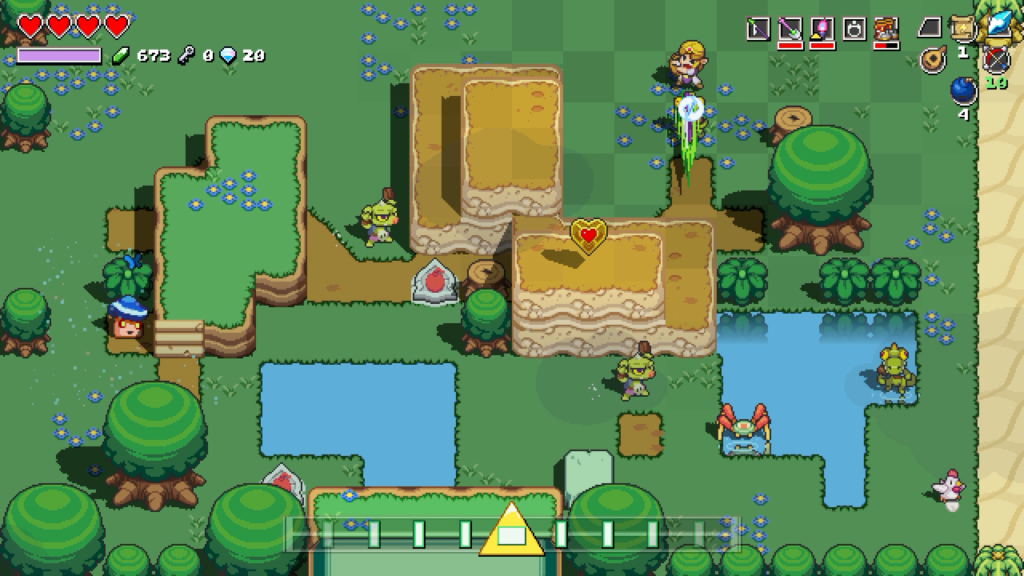
Another welcome change is how the player character’s equipment is handled upon death. Crypt of the NecroDancer is typical in its design where death strips the player character of all their pickups and send them to the beginning of a new dungeon layout. When I die in Cadence of Hyrule I respawn at fast travel points located throughout the world. The only items I drop are rupees and equipment that changes how I move through the environment, like torches, boots, and shovels. These items are easily and quickly replaced if lost, while everything else—everything else, including precious weapon drops—carries over to my next attempt.
A good example of how much this changes the difficulty is the War Drum item. The War Drum allows me to hop in place without missing the beat and also increases the damage of my next attack. This grants me the ability to lie in wait for an enemy without sacrificing my multiplier. Happening across a War Drum early in a NecroDancer run greatly increases my chances of success for that one attempt, but in Cadence of Hyrule that War Drum is mine to keep for every subsequent attempt.
Cadence of Hyrule refines the permadeath, dungeon-crawling design of its predecessor to make it more approachable to the rhythmically challenged and to fans more familiar with the Zelda half of its design.
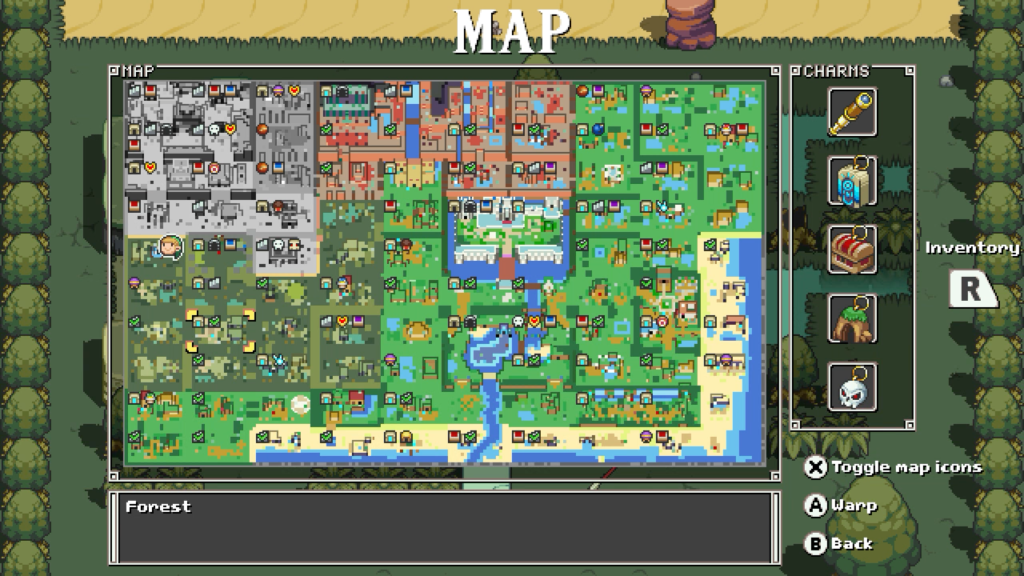
Though Cadence of Hyrule may play like a Crypt of the NecroDancer sequel, it still feels like a Legend of Zelda videogame. I progress through the quest by exploring the Hyrule overworld, which is made up of pre-built tiles that randomly arrange themselves on a grid to create a new overworld in every new save file. The quirks of this system can create radically different designs each time I start a new save file; in my first save file Kakariko Village may be just east of my starting point, while in another it may be on the other side of the map, across a river which needs specialized equipment to cross. This system keeps exploring Hyrule fresh no matter how many times I beat Cadence of Hyrule.
By exploring Hyrule I uncover caves that hide new equipment and upgrades, including the all-important Pieces of Heart that increase the player character’s total hit points. Early on things are hard when I have only three hit points, just like in many Legend of Zelda titles, but after a few hours of diligent exploration I have over a dozen hit points and several bottles filled with life-restoring potion that lets me charge zealously into combat. This, more than anything else, contributes to how much more forgiving Cadence of Hyrule is to play than Crypt of the NecroDancer: It borrows that forgivability from classic Zelda series design.
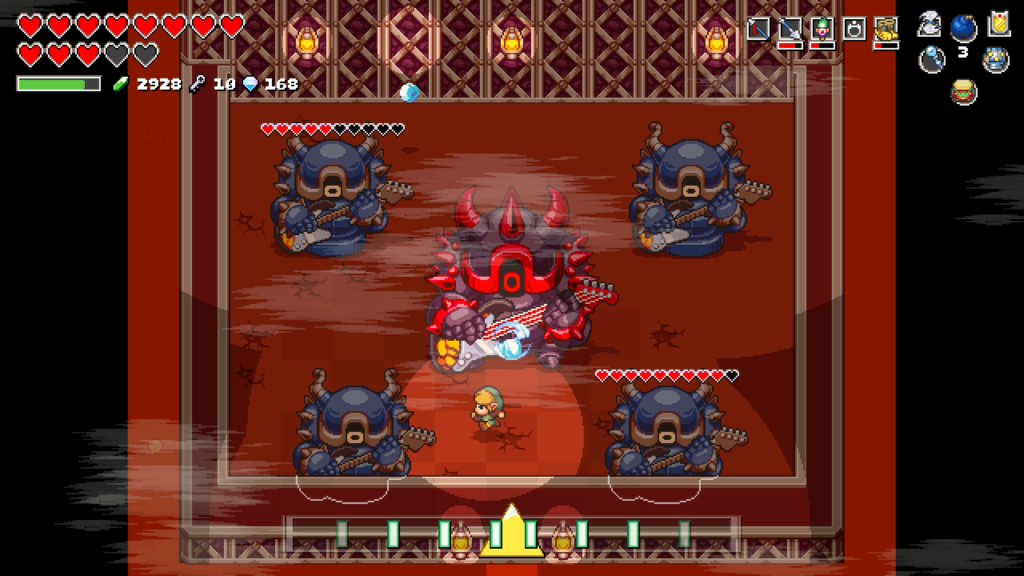
I progress through Cadence of Hyrule’s scenario by scouring Hyrule for its dungeons. Each floor is a procedurally generated selection of rooms and enemies with a miniboss that must be killed before the stairs to the next floor will open; this is pulled straight from NecroDancer level design. To keep things Zelda-flavored, some dungeon floors are prebuilt and focus on puzzle solving, and every dungeon is capped with a music-infused reimagining of a classic Zelda boss. After defeating all of the bosses at the end of all the dungeons, the final dungeon will open where I may challenge Octavo and put a stop to the dancing curse.
Cadence of Hyrule’s greatest accomplishment is how skillfully it balances influences from the two videogames it draws from, recognizable as a sequel or spinoff to both but not feeling apocryphal or heretical. This could easily have been a Zelda videogame that has too much of NecroDancer’s difficulty, or a NecroDancer videogame that has too much of Zelda’s rigidity, but it walks a narrow line between both extremes. I don’t discourage fans of either series from playing it, and I hope it serves as a gateway from one to the other.
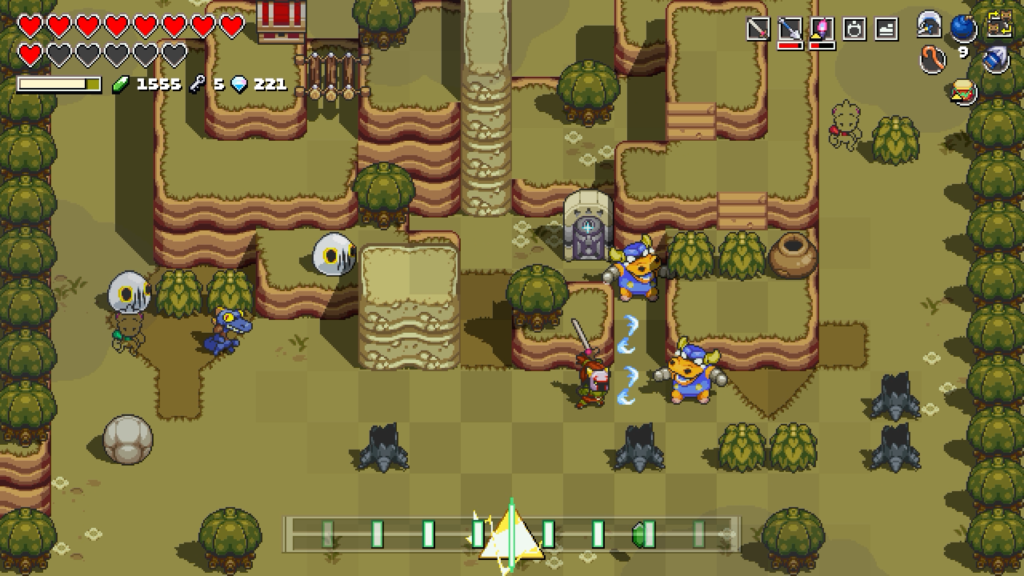
Cadence of Hyrule has benefitted from a great deal of post-release support. Most importantly are downloadable content that add new scenarios for me to navigate. Octavo’s Ode is identical to the base game, but lets me play as Octavo, who has a unique fighting style where he damages enemies by moving beside them rather than colliding with them, and has a new final boss.
Symphony of the Mask is a more profound piece of original content where I play as the Skull Kid who tries to save a future Hyrule where Link, Zelda, and Cadence failed to stop Octavo’s plot. I enjoyed this scenario the least of the entire Cadence of Hyrule package. The Skull Kid’s attacks and movement change based on the mask he is wearing. I found cycling through masks in real time to the beat of the music cumbersome and most of the Skull Kid’s unlockable masks to be superfluous. Symphony of the Mask also forces me to face the Temple of Brainstorms, a more traditional puzzle-focused Zelda dungeon where Cadence of Hyrule quickly reveals that its decision to use NecroDancer-style dungeons in its base game was a wise one.
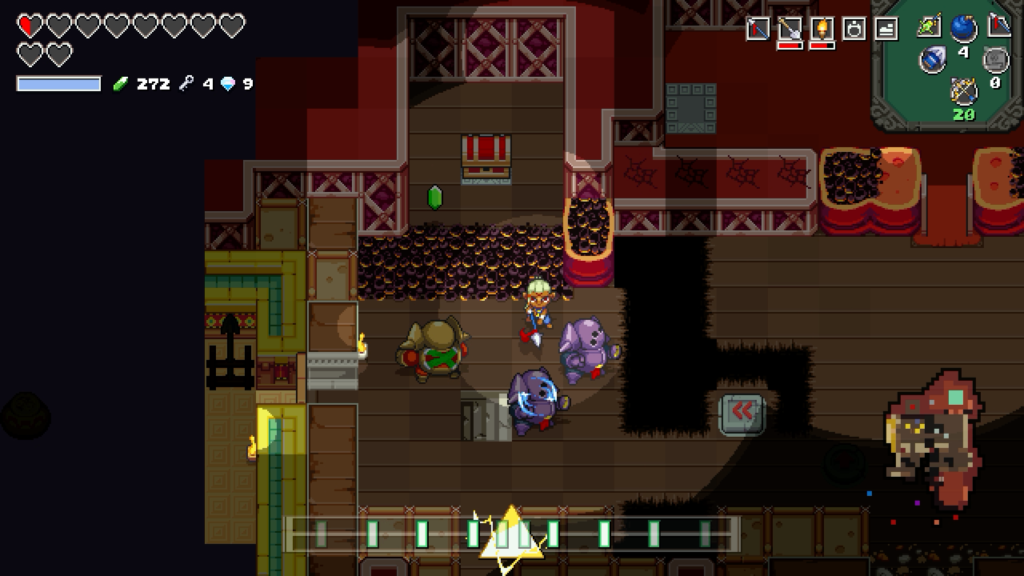
It’s in the Dungeon Mode where Cadence of Hyrule feels the most inspired and contemporary, slotting in snugly with the current “roguelite” zeitgeist. Dispensing with the Hyrule overworld, I select a character and delve into a fifteen-floor, NecroDancer-style dungeon that still retains all of the conveniences that make Cadence of Hyrule a more approachable videogame. I can earn equipment and upgrades like bottles, boomerangs, and Pieces of Heart by fully exploring each floor, and every three floors there is a checkpoint so I never have to start from scratch if I die.
Though I can only use one character in the entirety of my visit to Dungeon Mode, I have access to far more than the campaign allows. Impa, Shadow Link, and Shadow Zelda from the Zelda series, and Aria and Freddie Merchantry from NecroDancer are all playable, each bringing new mechanics to keep the randomized dungeons even more fresh and interesting. It’s a mode that feels more true to its NecroDancer roots but doesn’t abandon what makes the base videogame work so well, and I see myself returning to it far more often than the core adventure.
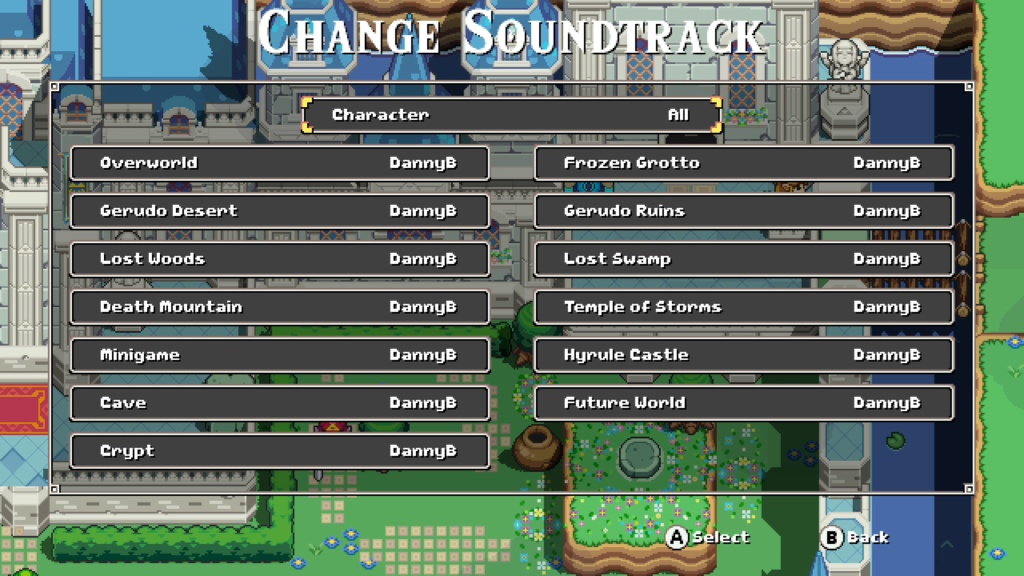
If there’s any reason to play Cadence of Hyrule: Crypt of the NecroDancer featuring The Legend of Zelda, other than it’s a great rhythm-adventure, it’s for its soundtrack. The Zelda series possesses without hyperbole one of the most incredible soundtracks in all of videogame composition. Past series titles have tried to incorporate music into Link’s quests, but Cadence of Hyrule is the first time it feels like that music is an intrinsic part of the play experience itself. It’s worth revisiting multiple times to hear the new remixes available in the music menu. It’s a celebration, focusing on classic tunes but throwing in flourishes recognizable from throughout the series’ long history.
If you’ve ever had a Zelda song stuck in your head and loved it, you should play Cadence of Hyrule. If you’ve ever played Crypt of the NecroDancer, whether you mastered it or thought it was too hard, you should play Cadence of Hyrule. If you’re a die-hard classic Zelda fan, you should play Cadence of Hyrule. It’s an essential entry in videogame design’s present obsession with procedural generation and dungeon crawling.